plante1999
International Hazard
    
Posts: 1936
Registered: 27-12-2010
Member Is Offline
Mood: Mad as a hatter
|
|
Dissolving silver
I dont have nitric acid so I attempted to disolve silver with 3% H2O2 and 5% Acetic (vinegar) , I own 1g of silver , I will buy more sometime , I also
aded 1keyboard mylar which contain silver but no copper/gold. The theorical ratio for disolving silver is about 15ml acetic acid and 15ml H2O2 but I
used an exess , I used 30ml acetic acid and 40ml H2O2 and waithed 30minute , I tested for silver with HCl and I got a positive result!, but I can not
even see the difference on my 1g silver piece , my scale give my a 0.01g less silver on my piece , so I suppose there is 0.01g+ in the sol. .
I will ad photo/video later.
Is there anybody here that have similar process for disolving silver?
[Edited on 14-1-2012 by plante1999]
I never asked for this.
|
|
|
blogfast25
International Hazard
    
Posts: 10562
Registered: 3-2-2008
Location: Neverland
Member Is Offline
Mood: No Mood
|
|
Ermm... three methods: nitric, nitric and... erm... nitric.
There really isn't much else that works and isn't a slow boat to China.
Try perhaps the "poor man's Aqua Regia": HCl + KNO3.
Use the search facility, if you haven't already.
|
|
|
AirCowPeaCock
Hazard to Others
  
Posts: 311
Registered: 9-1-2012
Location: In your nation!
Member Is Offline
Mood: Hazardous
|
|
You wouldn't get very far with nitric alone anyways. I dont think a mix of HCl and KNO3 would work either. But 20 g 12M HCl added to 10 g NH4Cl
fromcold packs oughta work..
BOLD
|
|
|
Mailinmypocket
International Hazard
    
Posts: 1351
Registered: 12-5-2011
Member Is Offline
Mood: No Mood
|
|
HNO3 dissolves Ag to form Ag(NO3)2
|
|
|
AirCowPeaCock
Hazard to Others
  
Posts: 311
Registered: 9-1-2012
Location: In your nation!
Member Is Offline
Mood: Hazardous
|
|
Ive heard it forms a layer around it of silver oxide from the oxidizing properties of HNO3 protecting it. But Ive never done it myself..
BOLD
|
|
|
Lambda-Eyde
National Hazard
   
Posts: 860
Registered: 20-11-2008
Location: Norway
Member Is Offline
Mood: Cleaved
|
|
No, silver form monovalent ions (with a few exceptions), so the salt you get from dissolving Ag in HNO<sub>3</sub> is
AgNO<sub>3</sub>
Quote: Originally posted by AirCowPeaCock  | | Ive heard it forms a layer around it of silver oxide from the oxidizing properties of HNO3 protecting it. But Ive never done it myself..
|
That happens with >95% HNO<sub>3</sub>, but not the more common azeotropic solution. Copper won't dissolve in fuming nitric acid, but
it dissolves readily with copious formation of nitrogen oxides in the 70% solution.
This just in: 95,5 % of the world population lives outside the USA
Please drop by our IRC channel: #sciencemadness @ irc.efnet.org
|
|
|
plante1999
International Hazard
    
Posts: 1936
Registered: 27-12-2010
Member Is Offline
Mood: Mad as a hatter
|
|
A quick video for SM users only.
<iframe sandbox width="420" height="315" src="http://www.youtube.com/embed/mOPiEZCf7ko" frameborder="0" allowfullscreen></iframe>
[Edited on 14-1-2012 by plante1999]
[Edited on 14-1-2012 by plante1999]
I never asked for this.
|
|
|
Mailinmypocket
International Hazard
    
Posts: 1351
Registered: 12-5-2011
Member Is Offline
Mood: No Mood
|
|
Quote: Originally posted by Lambda-Eyde  |
No, silver form monovalent ions (with a few exceptions), so the salt you get from dissolving Ag in HNO<sub>3</sub> is
AgNO<sub>3</sub> |
Ah right, I was thinking of lead nitrate! Thanks! 
|
|
|
cyanureeves
National Hazard
   
Posts: 744
Registered: 29-8-2010
Location: Mars
Member Is Offline
Mood: No Mood
|
|
i've used nitric acid. someone on this forum wrote that hot concentrated sulfuric will work.i have electrolyzed silver in ammonium hydroxide and got a
deep blue solution similar to prussian. the silver collects on the bottom as a sponge sandlike substance.
|
|
|
phlogiston
International Hazard
    
Posts: 1379
Registered: 26-4-2008
Location: Neon Thorium Erbium Lanthanum Neodymium Sulphur
Member Is Offline
Mood: pyrophoric
|
|
The "poor man's nitric acid" (HCl + KNO3) probably won't work because silver will precipitate as insoluble AgCl.
-----
"If a rocket goes up, who cares where it comes down, that's not my concern said Wernher von Braun" - Tom Lehrer |
|
|
AJKOER
Radically Dubious
    
Posts: 3026
Registered: 7-5-2011
Member Is Offline
Mood: No Mood
|
|
OK, your method of acetic acid/H2O2 has worked fine for me with periodic stirring. However, the reaction proceeds slowly (in a day or more, the
solution will develop some gray color as some of the Silver acetate breaks down and releases Ag). Caution, although the reaction is slow, I still
manged to make an obvious damaging cavity in a Sterling silver candle, having left it in the solution for a week.
Note, Silver acetate is NOT soluble in water, but does dissolve in acid solutions (like Acetic). So upon neutralizing the solution, white Silver
acetate will precipitate. Reacting with NaHCO3 will result in yellow Silver carbonate.
[Edited on 15-1-2012 by AJKOER]
|
|
|
cyanureeves
National Hazard
   
Posts: 744
Registered: 29-8-2010
Location: Mars
Member Is Offline
Mood: No Mood
|
|
its been a while since i've done anything with silver so i'm going to try it with kodak developing acetic acid and peroxide.
|
|
|
Aqua_Fortis_100%
Hazard to Others
  
Posts: 302
Registered: 24-12-2006
Location: Brazil
Member Is Offline
Mood: †
|
|
Whats interesting! Congrats Plante1999.
I was under impression that silver only dissolves on dilute HNO3 acting on it. Now, a complete home method to process silver mylar keyboards!
But I prefer x-rays scrap.. these are much richer in Ag!
Hope this wont be off topic, but since you people are talking about dissolving silver from keyboard, it would be nice to talk also about other scrap
sources of Ag here..
Acetate/protein bearing silver particles (like on x-ray sheets..black parts) and other photographic scrap, can be process in another way (still
oxidizing, but alkaline way).
The yield could go up to 5g Ag/m^2 x-ray.
Ive found that other Ag scrap, like X-ray can easily be processed with home bleach (2% bleach is just fine), it is very easy to do..
The gelatinous material used in photographic emulsions consists primarily of proteins which under the action of the alkaline bleach are hydrolyzed
slowly crumbling and releasing silver dispersed therein. So the silver can be attacked by the hypochlorite:
4 Ag + 2 ClO- + H2O -----> 2AgCl + Ag2O + 2OH-
You could easily reduce then AgCl/Ag2O with hot NaOH/sugar solution. The mud containing non-hydrolised matter , Ag, AgCl and Ag2O is reduced by
NaOH/sugar because beyond it will hydrolise all the organic remnants from bleach step, in hot alkaline-reducing media, all AgCl is converted in Ag2O
which oxidizes sugar to CO2, formic and levulinic acid (you can see acid smell during this step, even though solution is alkaline) and gets reduced
back to elemental Ag..
Get a shallow plastic or glass container and dilute 2% NaOCl bleach with water (3:2).
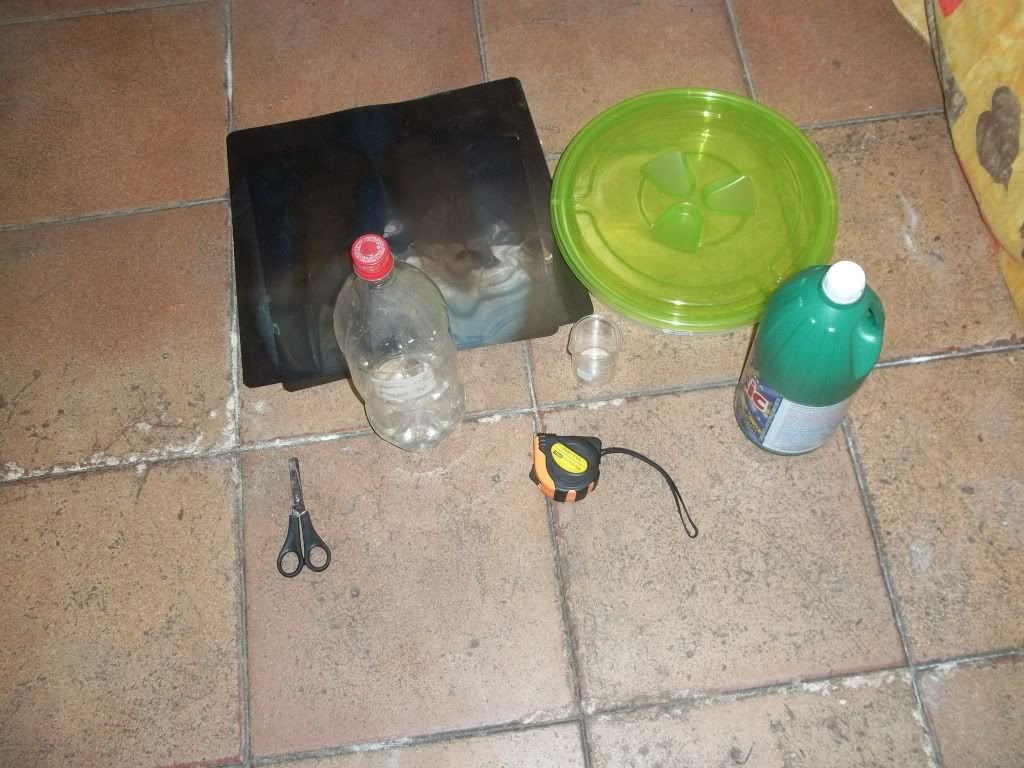
Put in cut squares of your x-ray scrap:
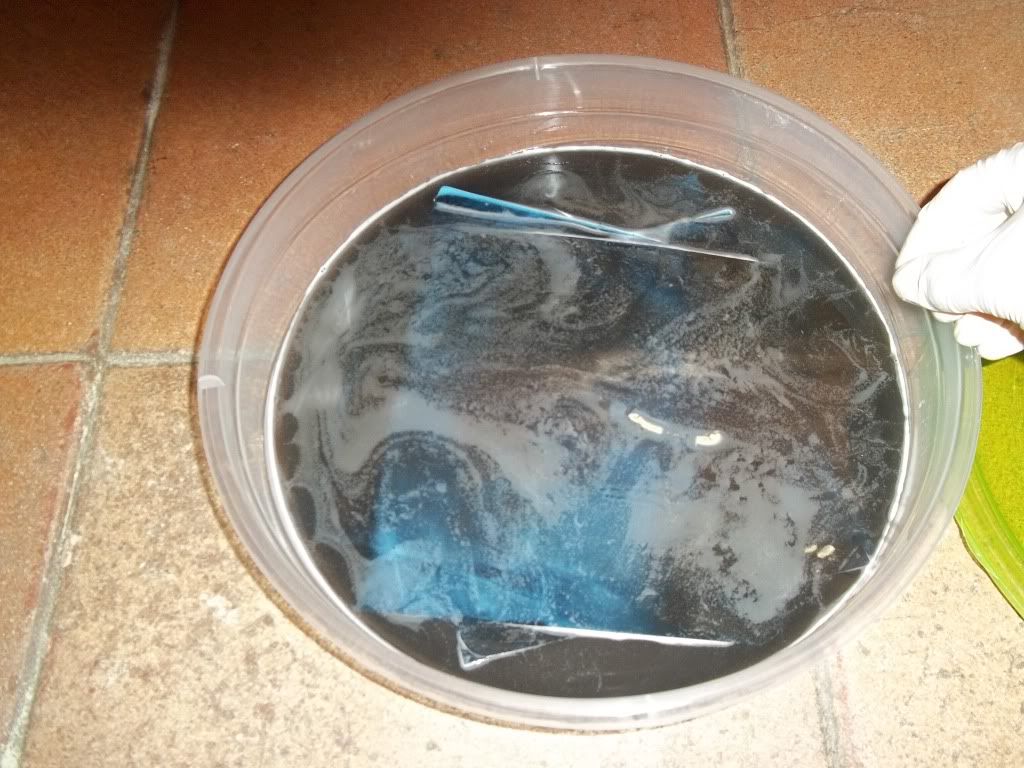
Bleach will eat x-ray film very fast, leaving transparent celluloid behind..
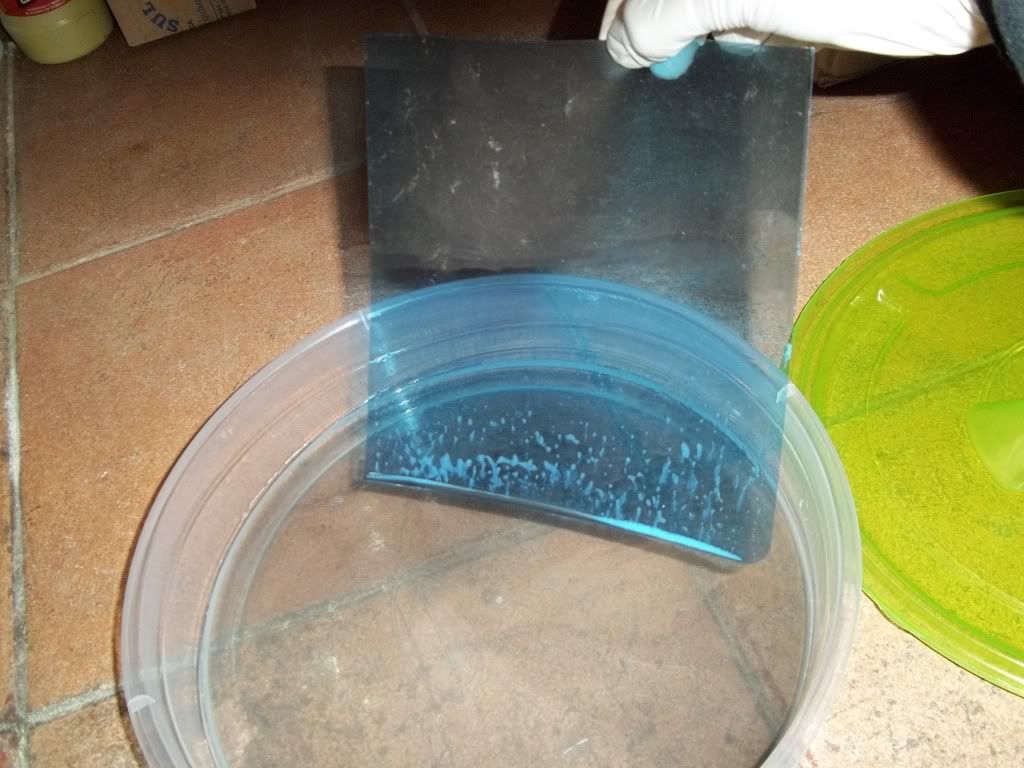
After done, spray it with water on the shallow dish, to bring down stuck AgCl..

Treated films.. It tooks about 10 mins to make about 4 foils (that were cut in smaller squares to fit in the dish..)
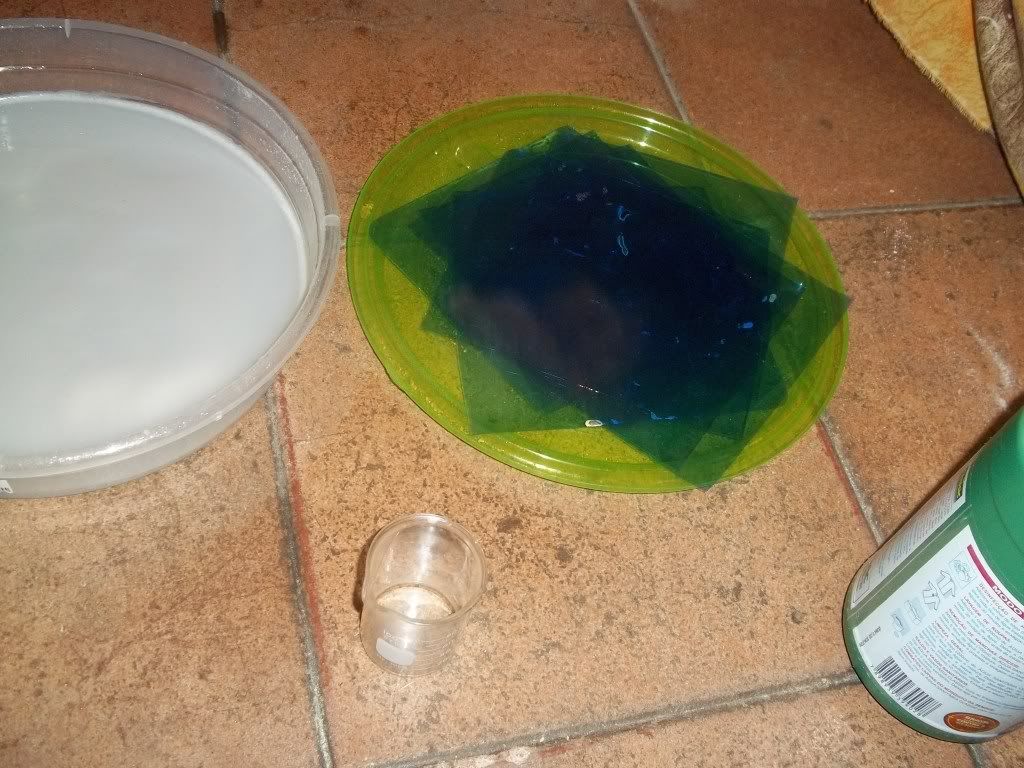
Plasticware dish with AgCl


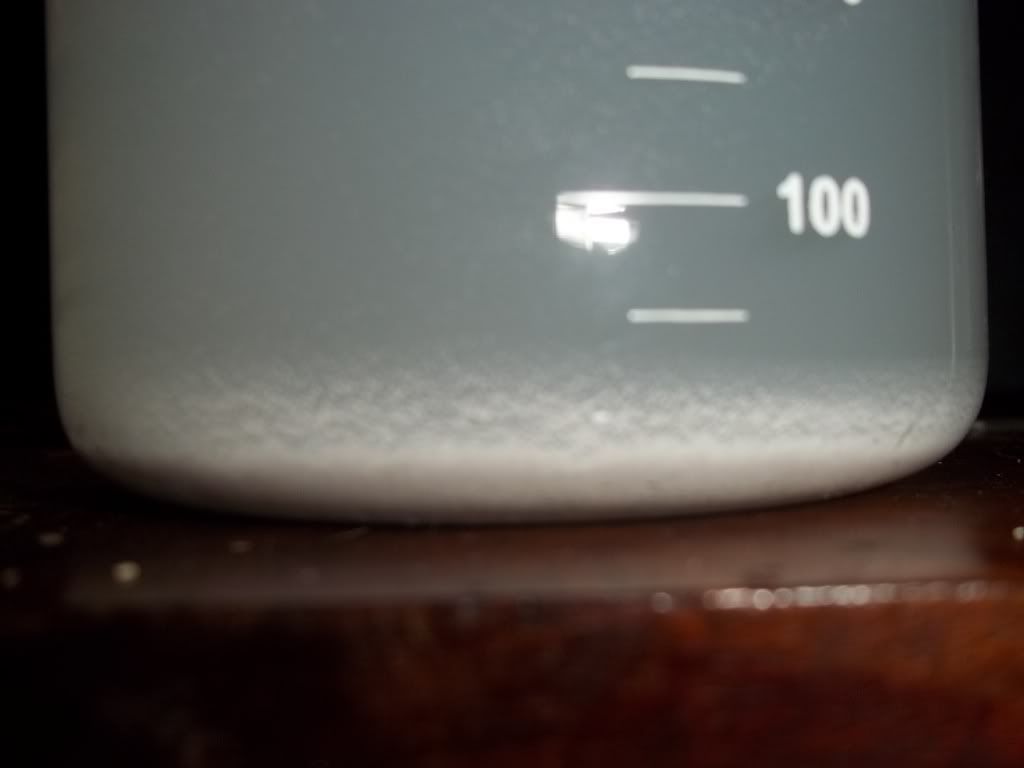
Carefully decant (it may take a day):
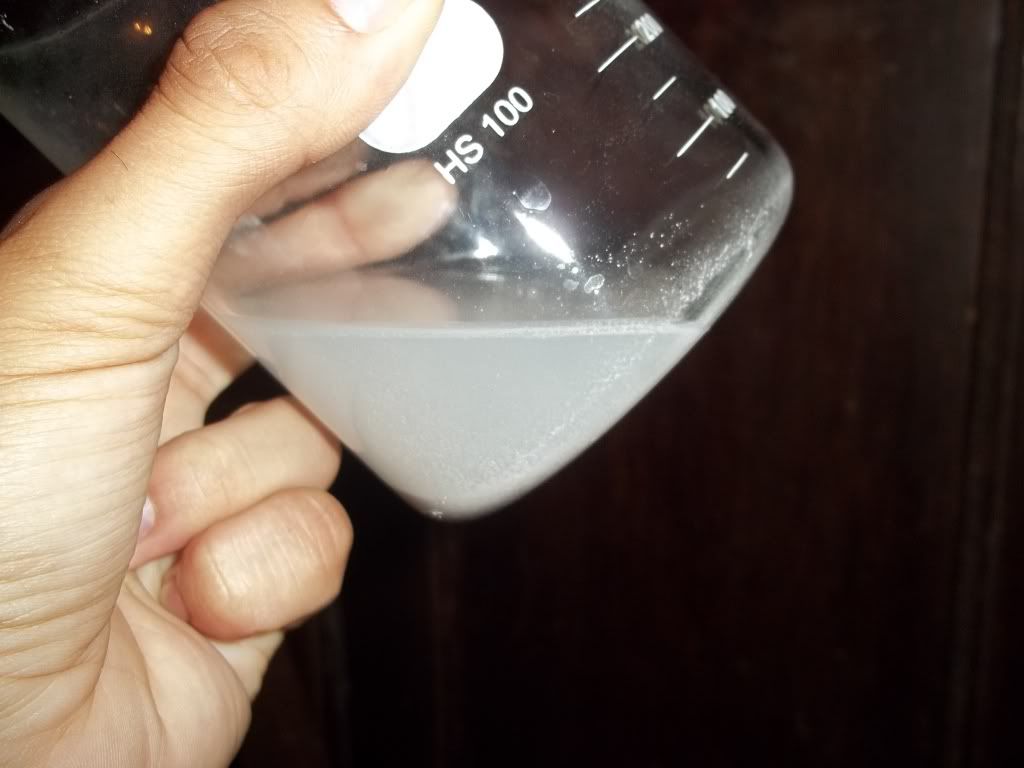
And reduce with hot NaOH/sucrose:
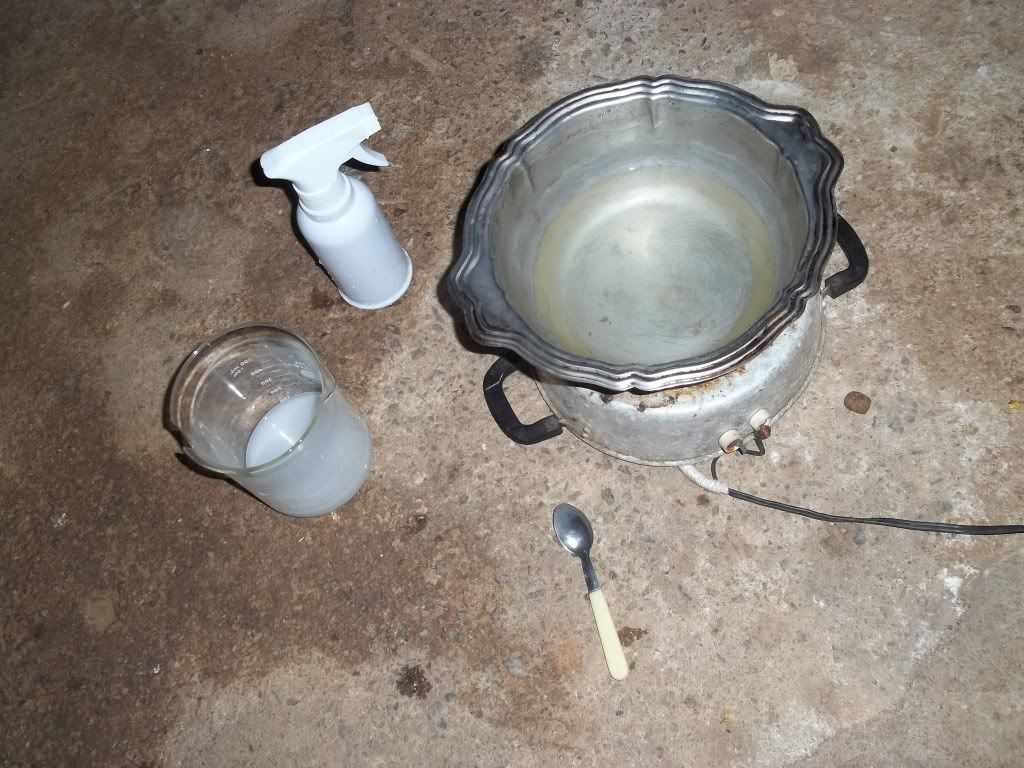
Unfortunatelly I dont have photo of the actual process, but is very simple.. The colour of mixed solution quickly turns light brown, dark brown then
grey/black.. Will try to make a video next time I put my hands on more x-ray films...
Filtering (neutralize it with mild acid BEFORE you filter, since hot NaOH solution will eat your filter paper. I learned this through bad way)..

Save the filter paper used to filter Ag. It is impregnated and could be processed later along with other silver scraps with dilute HNO3 (or Plante1999
proposal of acetic/H2O2 )
Ag powder from previous runs:
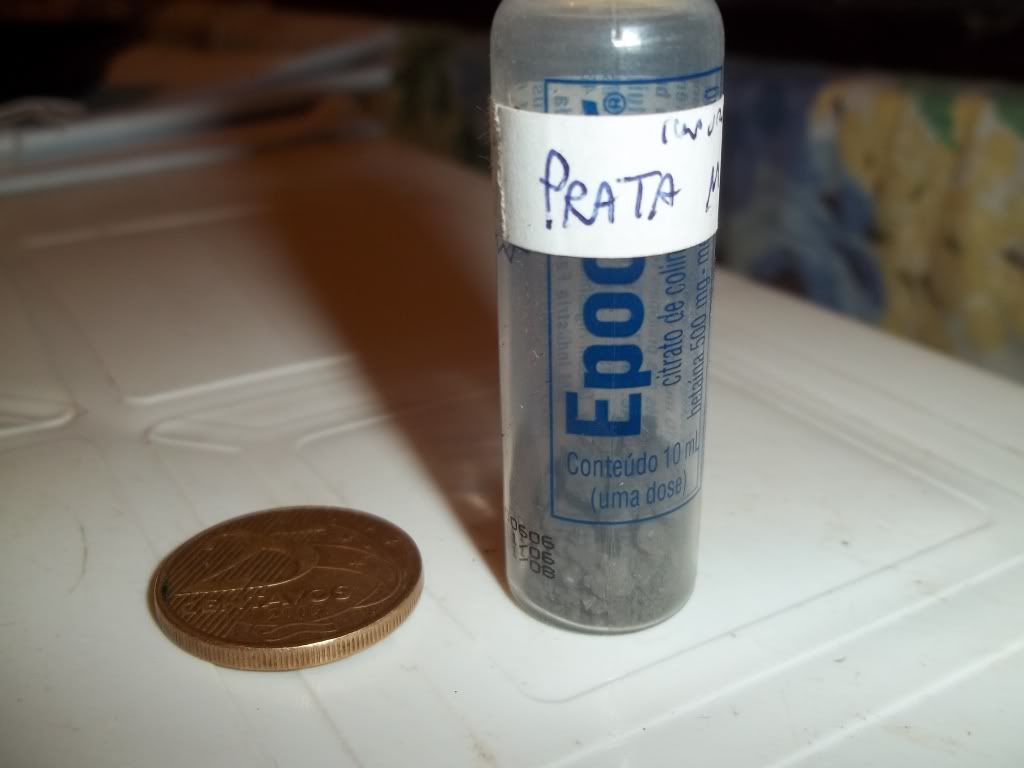
There are of course patents of process.. e.g.
http://www.freepatentsonline.com/3960550.pdf
though this is a bit different and harder to do at home.. But gives ideas on how to melt/purify your silver..
"The secret of freedom lies in educating people, whereas the secret of tyranny is in keeping them ignorant."
|
|
|
AJKOER
Radically Dubious
    
Posts: 3026
Registered: 7-5-2011
Member Is Offline
Mood: No Mood
|
|
Some of the chemistry per my research, see "The principles of chemistry", Volume 2, by Dmitrïi Ivanovich Mendelieev.
From the bottom of page 403:
"This is how he describes the phenomenon which then takes place: if silver oxide or carbonate be suspended in water, and an excess of water saturated
with chlorine be added, then all the silver is converted into chloride, just as is the case with oxide or carbonate of mercury, and the water then
contains, besides the excess of chlorine, only pure hypochlorous acid without the least trace of chloric or chlorous acid. If a stream of chlorine be
passed into water containing an excess of silver oxide or silver carbonate, while the liquid is continually shaken, then the reaction is the same as
the preceding; silver chloride and hypochlorous acid are formed. But this acid does not long remain in a free state; it gradually acts on the silver
oxide and gives silver hypochlorite. If, after some time, the current of chlorine is stopped but the shaking is continued, then the liquid loses its
characteristic odour of hypochlorous acid, while preserving its energetic decolorising property, because the silver hypochlorite which is formed is
easily soluble in water. In the presence of an excess of silver oxide this salt can be kept for several days without decomposition, but it is
exceedingly unstable when there is not an excess of silver oxide or carbonate present. So long as the solution of silver hypochlorite is shaken up
with the silver oxide, it preserves its transparency and bleaching property, but directly it is allowed to stand, and the silver oxide settles, it
becomes rapidly cloudy and deposits large flakes of silver chloride, so that the black silver oxide which hud settled becomes covered with the white
precipitate. The liquid then loses its bleaching properties, and contains silver chlorato iu solution,...."
And from the bottom of page 404:
" In this manner the reactions whiih are consecutively accomplished may be expressed by the equations:
6Cl2 + 3Ag2O + 3H2O = 6AgCl + 6HCl0; 6HCl0 + 8Ag20 = 3 H20 + 6AgCIO;
6AgClO = 4AgCl + 2AgCl03.
Hence, Slas gives the following method for the preparation of silver chlorate. A slow current of chlorine is caused to act on oxide of silver,
suspended in water, which is put into a state of continuous movement. The shaking is continued after the supply of chlorine has been stopped, in order
that the free hypochlorous acid should pass into silver hypochlorite, and the resultant solution of the hypochlorite is drawn off from the sediment of
the excess of silver oxide. This solution decomposes spontaneously into silver chloride and chlorate. The pure silver chlorate, AgClO3, does not
change under the action of light. The salt is made ready for further use by drying it in dry air at 150°. It is necessary during drying to prevent
the access of any organic matter; this is done by filtering the air through cotton wool, and passing it over a layer of red-hot copper oxide."
LINK:
http://books.google.com/books?pg=PA403&lpg=PA403&dq=...
So either the presence of free Chlorine in the bleach (which effectively lows the pH by forming HCl and also HOCl), or by the direct addition of a
weak acid (like CO2 or vinegar) forming HOCl, which reacts directly with Ag2O or AgCO3 to create the highly unstable silver hypochlorite. Then, AgClO
quickly disproportionates into AgCl and AgClO3 unless there is an excess of Ag2O or AgCO3 to promote the stability of the Silver hypochlorite.
I had added NaClO to Silver acetate dissolved in Acetic acid. The bleach and weak acid formed HOCl, which then reacted with Silver acetate to form a
white precipitate of AgCl. The solution also bubbled for a few weeks (O2 from the decomposition of AgClO3).
[Edited on 15-1-2012 by AJKOER]
|
|
|
plante1999
International Hazard
    
Posts: 1936
Registered: 27-12-2010
Member Is Offline
Mood: Mad as a hatter
|
|
Silver chlorate would be a fantastic solube silver salt if it was easy to make!
I never asked for this.
|
|
|
cyanureeves
National Hazard
   
Posts: 744
Registered: 29-8-2010
Location: Mars
Member Is Offline
Mood: No Mood
|
|
the silver i use came from x-ray film used in a hospital.it was given to all hospital employees as a yearly bonus in the form of a 99.99 1 troy ounce
silver coin.
|
|
|
LanthanumK
Hazard to Others
  
Posts: 298
Registered: 20-5-2011
Location: New Jersey
Member Is Offline
Mood: No Mood
|
|
I recently dissolved silver wire with HAc/H2O2. It did not work with ordinary shiny silver wire. However, I "activated" the wire by anodizing it in
concentrated sodium chloride solution. The electrolysis soon stops and a white crust of silver chloride is visible on the wire. Place this corroded
wire in the HAc/H2O2 and catalytic decomposition results, while a cloudy Cl(-) contaminated AgAc solution leaves the silver wire. In a day, the silver
wire is disintegrated.
hibernating...
|
|
|
AJKOER
Radically Dubious
    
Posts: 3026
Registered: 7-5-2011
Member Is Offline
Mood: No Mood
|
|
Plante1999:
See my reference on Silver Chlorate formation. Here is another one:
Source: "A comprehensive treatise on inorganic and theoretical chemistry, Volume 2, by Joseph William Mellor, page 271. To quote:
"L. N. Vauquelin found that when chlorine acts on silver oxide diffused in water, a mixture of silver chloride and chlorate is formed, and it was
accordingly supposed that these same products are obtained when chlorine acts on the salts of silver. The products observed by L. N. Vauquelin were
shown by A. J. Balard to be end products, being preceded by the formation of silver hypochlorite. According to A. J. Balard, finely divided silver
immediately decomposes hypochlorous acid with the evolution of oxygen, and the formation of silver chloride. Again, if an alkali hypochlorite be
treated with silver nitrate, or if silver oxide, Ag20, suspended in water, be treated with chlorine, much heat is developed and silver chloride and
silver peroxide are precipitated while a liquid with bleaching properties is formed. The liquid is very unstable, and decomposes in a few minutes with
the separation of silver chloride and the formation of a soln. of silver chlorate which does not bleach. If an excess of chlorine be employed, all the
silver is precipitated and a soln. of hypochlorous and chloric acids remains. If an alkali hydroxide be added to the bleaching liquid, oxygen is
evolved, and a mixture of silver chloride and peroxide is precipitated. Similar results are obtained if an aq. soln. of silver chlorate, nitrate, or
acetate be employed except that the corresponding acid is liberated. J. S. Stas has •shown that probably no chloric acid or silver chlorate is
formed in the primary reaction:
Ag20+2Cl2+H20=2AgCl+2HCl0
If the silver oxide or carbonate be in excess, the silver oxide gradually forms silver hypochlorite,
2HOCl + Ag20 =2AgOCl+H20
which is readily soluble, and the soln. is stable so long as it is shaken with the excess of silver oxide present. This salt is partially decomposed
on standing in darkness, and completely decomposed at 60° into silver chloride and chlorate:
3AgOCl=2AgCl+AgCl03
and the latter remains in soln. in the alkaline liquid. J. S. Stas found no signs of the formation of perchloric acid. F. Raschig prepared silver
hypochlorite by the action of alkaline sodium hypochlorite on silver nitrate, and also by adding a soln. of silver nitrate to sodium azide, NaN3, or
to a soln. of chloroazide in sodium hydroxide."
LINK:
http://books.google.com/books?pg=PA271&lpg=PA271&dq=...
So the formation of Silver Chlorate is apparently not slow and one can actually visibly observe the formation of the AgCl. I suspect that AgClO3
should be quickly be employed in a reaction, or dried per the directions, as the aqueous solution is most likely not stable. In fact, Mellor (cited
previously), page 340, notes that AgClO3 decomposes into AgCl and O2 in the presence of HCl, HNO3 and even Acetic acid. Chlorine also reacts forming
AgCl, HClO3 and O2.
To comment on why one would not try to make AgClO3 as the soluble salt of choice is that only 1/3 of the Silver metal is converted into a soluble
salt.
In addition to the aqueous stability issue of AgClO3, the generally slow dissolution of Silver metal itself into a salt and the cost of the acids, the
main issue of say large scale production of, for example KClO3 (by adding KCl to AgClO3), remains the inherent cost of the Silver itself even with
recycling.
[Edited on 16-1-2012 by AJKOER]
|
|
|
plante1999
International Hazard
    
Posts: 1936
Registered: 27-12-2010
Member Is Offline
Mood: Mad as a hatter
|
|
This weekend I will try the mixed H2O2/acetate/NaClO process to get silver from keyboard mylar.
thanks Aqua_Fortis_100% for the idee.
report this weekend.
I never asked for this.
|
|
|